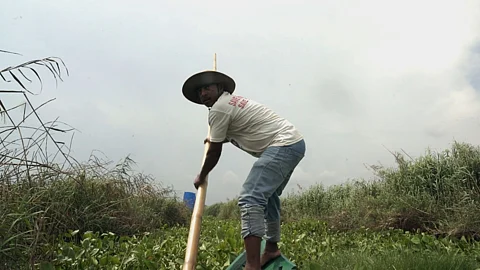
- HOMEGROWN WORLD
- #HGCREATORS
- #HGEXPLORE
- #HGVOICES
- #HGSHOP
- CAREERS
- ABOUT US
- CONTACT US

"Chilika is a jewel," says conservationist and researcher Tiasa Adhya. "It’s a natural heritage of the world." With its shimmering expanse of brackish water along the coast of Odisha, this lake is a delicate engine of survival. Its winding marshes and shallow waters support entire communities: families who fish, dolphins that surface at dusk, otters and flocks of migratory birds, and elusive wild cats that hunt in silence. But what happens when this ecosystem begins to falter?
This is the question that drives Chandra Mouli Mallampalli's documentary 'Searching for Choti' that recently screened at the EcoReels Film Festival 2025 in New Delhi. The film follows local fisherman and conservationist Subas Behera, and wildlife filmmaker Giridhar Nayak, as they navigate the Chilika wetlands in search of the rare and mysterious Fishing Cat.
These wild cats, known for their striking grey coats and affinity for water, are notoriously difficult to spot. But one in particular has captured the hearts of those who frequent the lake: a cat with a damaged leg named 'Choti'. Subas, who named her, has come to know her habits and quirks over time — a bond that reflects a larger truth about the human-wildlife relationship in Chilika. In the film, Choti becomes a symbol of how intricately intertwined life is around the lagoon.
As Subas and Giridhar comb through the marshes and camera trap footage, their search becomes both literal and symbolic. Searching for Choti offers rare glimpses of the animal, but it’s also a meditation on the fragility of the ecosystem. Chemical-laden water flows into the lake, affecting the fish, and by extension, every human and non-human that depends on them. The film highlights how people like Subas now work to protect their environment with the tenderness one might reserve for a child.
Mallampalli’s storytelling, supported by Nayak’s cinematography and additional work by Robin Fisher, brings an intimacy to the narrative. His experience with the BBC and Nat Geo Wild is evident in his stylistic and thematic choices. He allows local voices to take the lead and trusts the emotional resonance of the everyday.
By exploring Subas' relationship with Choti, the film reveals a form of ecological solidarity shaped by lived experience. It’s this grounded connection between people and place that gives the documentary its heart, offering a blueprint of conservation that begins with attention, respect, and care.
Follow Chandra Mouli here.
If you enjoyed reading this here's more from Homegrown:
Ghost Of The Mountain' Is An Indian Cinematic Ode To The World's Most Elusive Animal
A Homegrown Documentary Captures The Loss Of Koli Community's Connection With The Sea
Saved By A Curse: This Documentary Shows Us Why The Chambal River Remains Pristine
